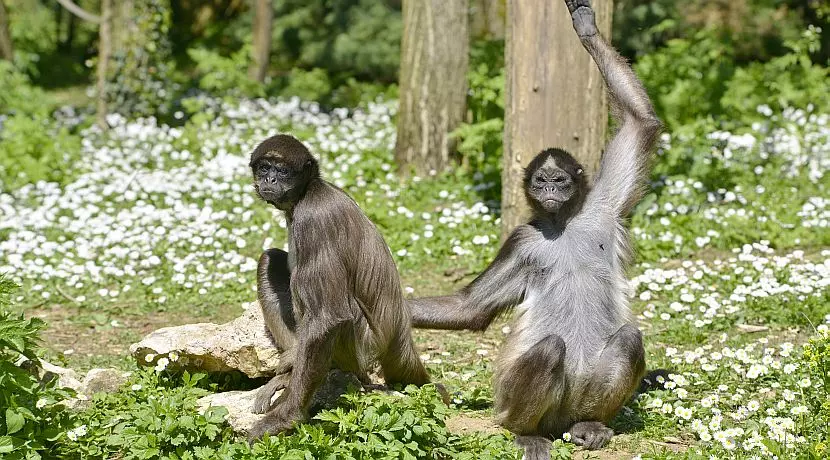Spending a large amount of time up in the trees, well away from human eyes, it is sometimes hard to know how many monkeys there are left in the world today. Whilst some species of primate are flourishing and adapting to their environment, others are not and some species of monkey are in real danger of becoming extinct very soon. One of the best ways to slow this process is to raise awareness of just how low some monkey numbers have fallen, and today we will be looking at 5 of the most endangered monkey species left in the world.
Tana River Red Colobus Monkey
The Tana River red colobus is endemic to a narrow zone of forest near the Tana River in Kenya from which it gets its name. These monkeys are leaf eaters and occasionally supplement their diet with fruit and roots.
The reason why the Tana River red colobus is endangered is down to human interference. As more and more of the indigenous forest is cut down, these monkeys are confined to a smaller and smaller area and the pressure for food and resources has simply become too much for these primates to recover from. Add this to the fact that they are often hunted for their meat by humans and you can begin to see why they are so endangered.
Estimated Numbers: 1,100 – 1,300
Tonkin snub-nosed Monkey

This small monkey is famed for its distinctive facial features. They have a pink nose and lips and blue patches around their eyes! You will only find the Tonkin in its endemic homeland of Vietnam, and these primates prefer to live in land that is 200 to 1,200 meters above sea level.
Tonkins snub-nose monkeys are in danger of becoming extinct for two reasons. The first is habitat loss with their forest homes being chopped down at an alarming rate, and the second is through hunting. Despite being a flagship species and often receiving a lot of international attention, their numbers are still falling and it is looking increasingly likely that we will lose the Tonkin sub-nosed monkey sooner rather than later.
Estimated Numbers: 200 – 250
Eastern Black Crested Gibbon

As one of the most elusive and rare primates in the entire world, the Eastern Black Crested Gibbon was thought to be completely extinct right up until a small population was discovered in 2002. This group of around 35 gibbons was found in northeast Vietnam, and with just ten others thought to be alive across the border in China, this is an animal which is suffering badly.
As is the case with many other animals all around the world, the Eastern Black Crested Gibbons critically endangered status comes as a result of deforestation, habitat encroachment, and poaching.
Estimated Numbers: 35 – 50
Brown Spider Monkey

Picture Credit Goes To By http://www.birdphotos.com edit by Fir0002 - Image:BrownSpiderMonkey.jpg, CC BY-SA 3.0, https://commons.wikimedia.org/w/index.php?curid=49...
The Brown Spider Monkey comes from the forests of northern Colombia and north-western Venezuela. Like all other species of spider monkey it has long, spindly limbs and a very long prehensile tail which it is able to use almost as a fifth limb! This monkey has an off white stomach and sometimes even pale blue eyes which are very uncommon in monkey species.
The Brown Spider Monkey lives in small groups up high in the canopy, and this is why they are facing population problems. The areas of forest they prefer to reside in are considered perfect for logging, and as a result they are losing their home at a worrying rate. The average lifespan of a spider monkey is 27 years, but many will never make it to this milestone as their home is being ripped away in front of their eyes.
Estimated Numbers – Unknown but low
Northern Brown Howler Monkey

Picture Credit Goes To By Kenny Ross - Flickr, CC BY-SA 2.0, https://commons.wikimedia.org/w/index.php?curid=25...
The Northern Brown Howler Monkey is so rare that there is very little information known about it. However, what we do know is that it is native to Brazil and has been classed as critically endangered by the IUCN. Being a howler monkey, this primate is known for its distinctive (and loud) call which can be heard from quite a distance away!
The Northern Brown Howler’s population has taken a hit from not only poaching and deforestation, but also through disease epidemics that have hit the area over time. With groups of monkeys living in such close proximity to each other, when a disease enters the area in which they live, there is a very high chance that they will all catch it and could perish as a result.
Estimated Numbers – Fewer than 250
People often have a certain affinity with monkeys as it is easy to see some of yourself in these cheeky chaps. With their occasionally human-like mannerisms and behaviours they are many people’s favourite animals, but if we do not help them soon, many will disappear off the face of the earth for good.
There are many ways you can get involved in monkey conservation. You could get your hands dirty by volunteering at a conservation project, you could help us to raise awareness by sharing this post or even writing your own, or you could do something as simple as donating to a worthy monkey based charity/project such as Monkey World! The choice is yours, but they need your help now more than ever…














